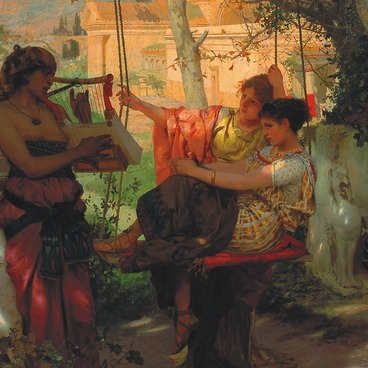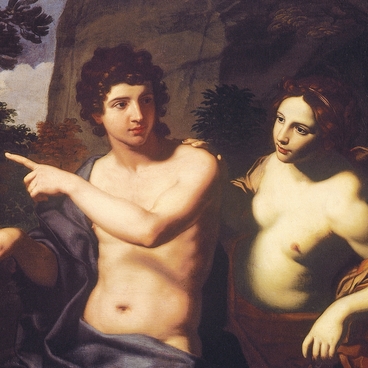Carl Andreas Ruthart was a German painter, drawing artists and engraver, the author of historical and animalistic scenes.
He studied in Danzig (today’s Gdańsk), was an apprentice of Daniel Schultz, a Polish master of German descent. In 1652, he began to work in Venice and Rome, and from 1663 to 1664, he stayed in Antwerp. There he joined a guild of artists and was studying the works of Flemish masters featuring animals.
Ruthart considered himself to be a follower of Peter Paul Rubens. Initially, he specialized in depicting predators, especially large cats.
As time went by, Carl Ruthart won a reputation as an artist who is competent in animal anatomy and is skillful in depicting animals in various situations and scenes, from mythological to biblical to idyllic ones.
Flemish artist Wilhelm Schubert van Ehrenberg turned to Ruthart on multiple occasions, and the latter added animals to van Ehrenberg’s architectural and natural landscapes.
Between 1665 and 1671, Ruthart passed through Regensburg and Vienna. When he moved to Italy in 1672, he turned to decorating churches and, soon after, took vows. The remainder of his life Ruthart spent at a monastery in L’Aquila, painting sacred subjects.
This work is characterized by reserved and subdued colors, with light and shadow alternating in the foreground. The composition was made especially spectacular by its angle. The deer who literally has made a leap above the earth in his desperate dash for survival and the hounds overtaking him are shown in a close-up view, against the sky.
The author’s signature and date in the lower right-hand corner were discovered in 1970, when the picture was being restored at the workshops of the Academician I.E. Grabar All-Russia Art Research and Restoration Centre.
Large-sized decorative tableaus of this kind were a favorite adornment of Baroque-styled staterooms. The hunting theme, which instilled aristocratic spirit in the interior, was extremely popular.
This composition belongs to the same Baroque tradition of visual appeal as typical works of the middle period of Carl Ruthart’s career as an artist. It is similar to the hunting cycles featuring carnivorous and grass-eating animals that are on display at museums in Paris, Munich and Leipzig; they have evocative titles, e.g., Bear Hunt. The same style was used for the work Leopards Attacking a Deer kept at the Art Gallery of the Smolensk State Museum-Reserve.
He studied in Danzig (today’s Gdańsk), was an apprentice of Daniel Schultz, a Polish master of German descent. In 1652, he began to work in Venice and Rome, and from 1663 to 1664, he stayed in Antwerp. There he joined a guild of artists and was studying the works of Flemish masters featuring animals.
Ruthart considered himself to be a follower of Peter Paul Rubens. Initially, he specialized in depicting predators, especially large cats.
As time went by, Carl Ruthart won a reputation as an artist who is competent in animal anatomy and is skillful in depicting animals in various situations and scenes, from mythological to biblical to idyllic ones.
Flemish artist Wilhelm Schubert van Ehrenberg turned to Ruthart on multiple occasions, and the latter added animals to van Ehrenberg’s architectural and natural landscapes.
Between 1665 and 1671, Ruthart passed through Regensburg and Vienna. When he moved to Italy in 1672, he turned to decorating churches and, soon after, took vows. The remainder of his life Ruthart spent at a monastery in L’Aquila, painting sacred subjects.
This work is characterized by reserved and subdued colors, with light and shadow alternating in the foreground. The composition was made especially spectacular by its angle. The deer who literally has made a leap above the earth in his desperate dash for survival and the hounds overtaking him are shown in a close-up view, against the sky.
The author’s signature and date in the lower right-hand corner were discovered in 1970, when the picture was being restored at the workshops of the Academician I.E. Grabar All-Russia Art Research and Restoration Centre.
Large-sized decorative tableaus of this kind were a favorite adornment of Baroque-styled staterooms. The hunting theme, which instilled aristocratic spirit in the interior, was extremely popular.
This composition belongs to the same Baroque tradition of visual appeal as typical works of the middle period of Carl Ruthart’s career as an artist. It is similar to the hunting cycles featuring carnivorous and grass-eating animals that are on display at museums in Paris, Munich and Leipzig; they have evocative titles, e.g., Bear Hunt. The same style was used for the work Leopards Attacking a Deer kept at the Art Gallery of the Smolensk State Museum-Reserve.



